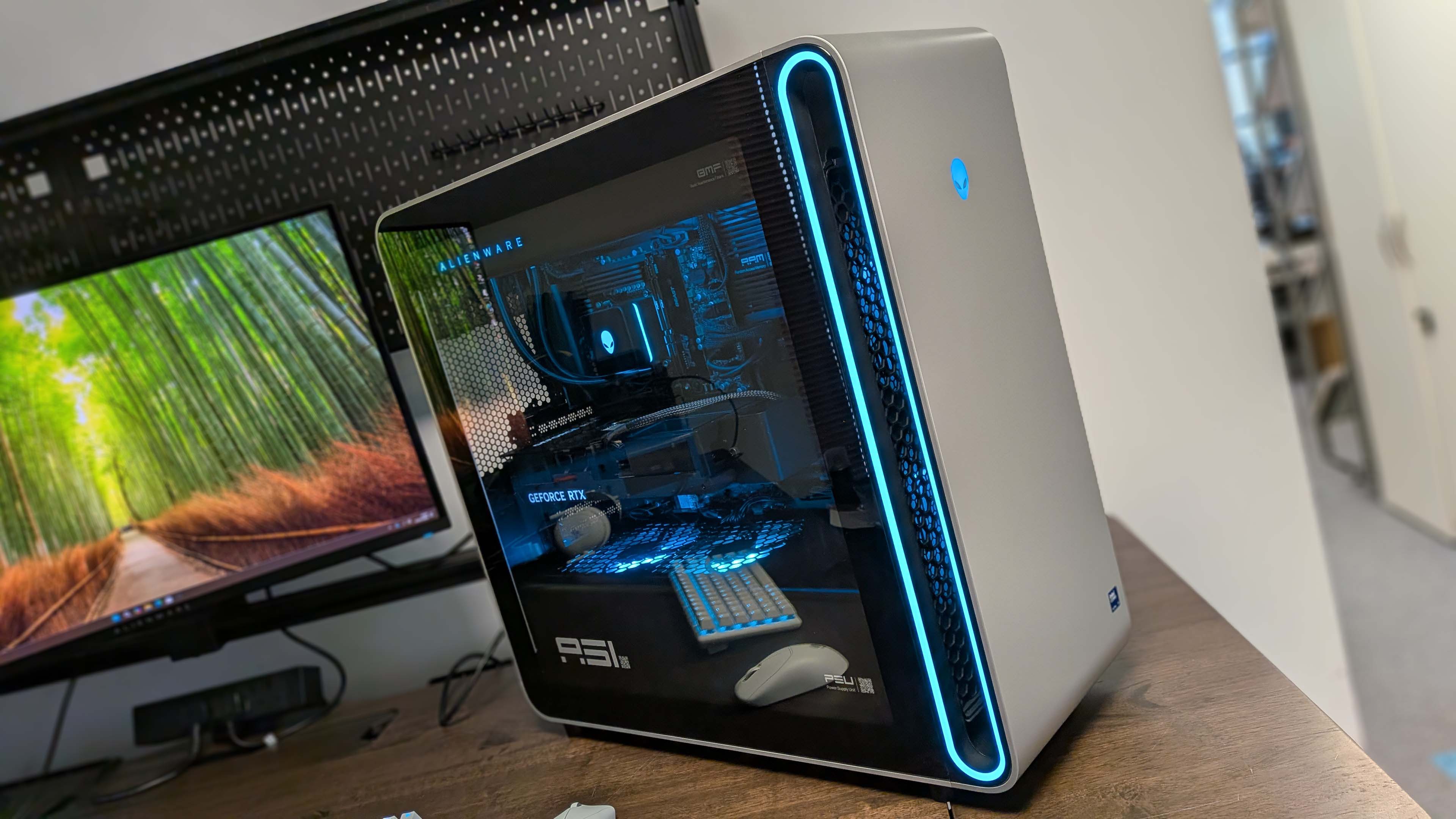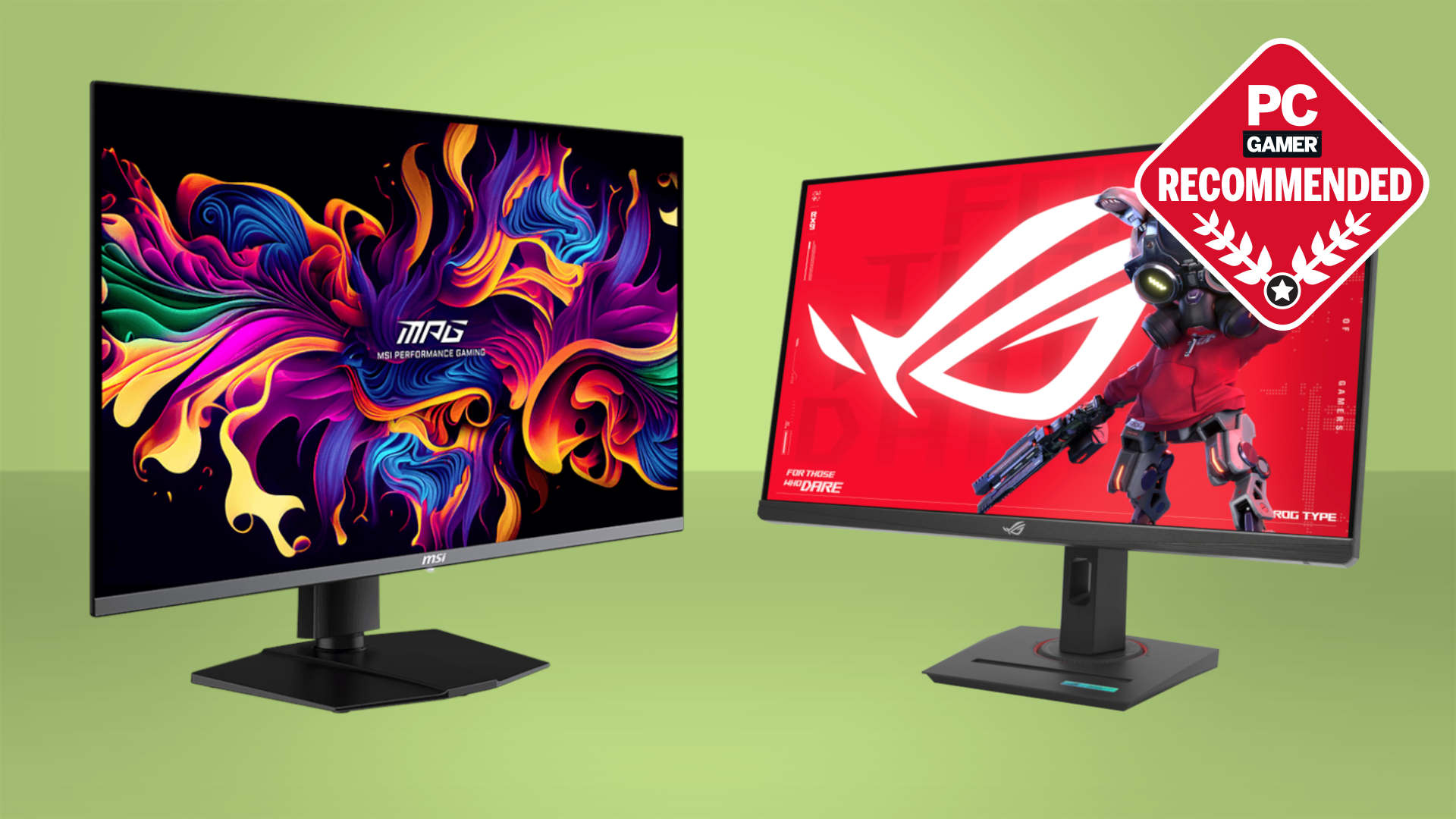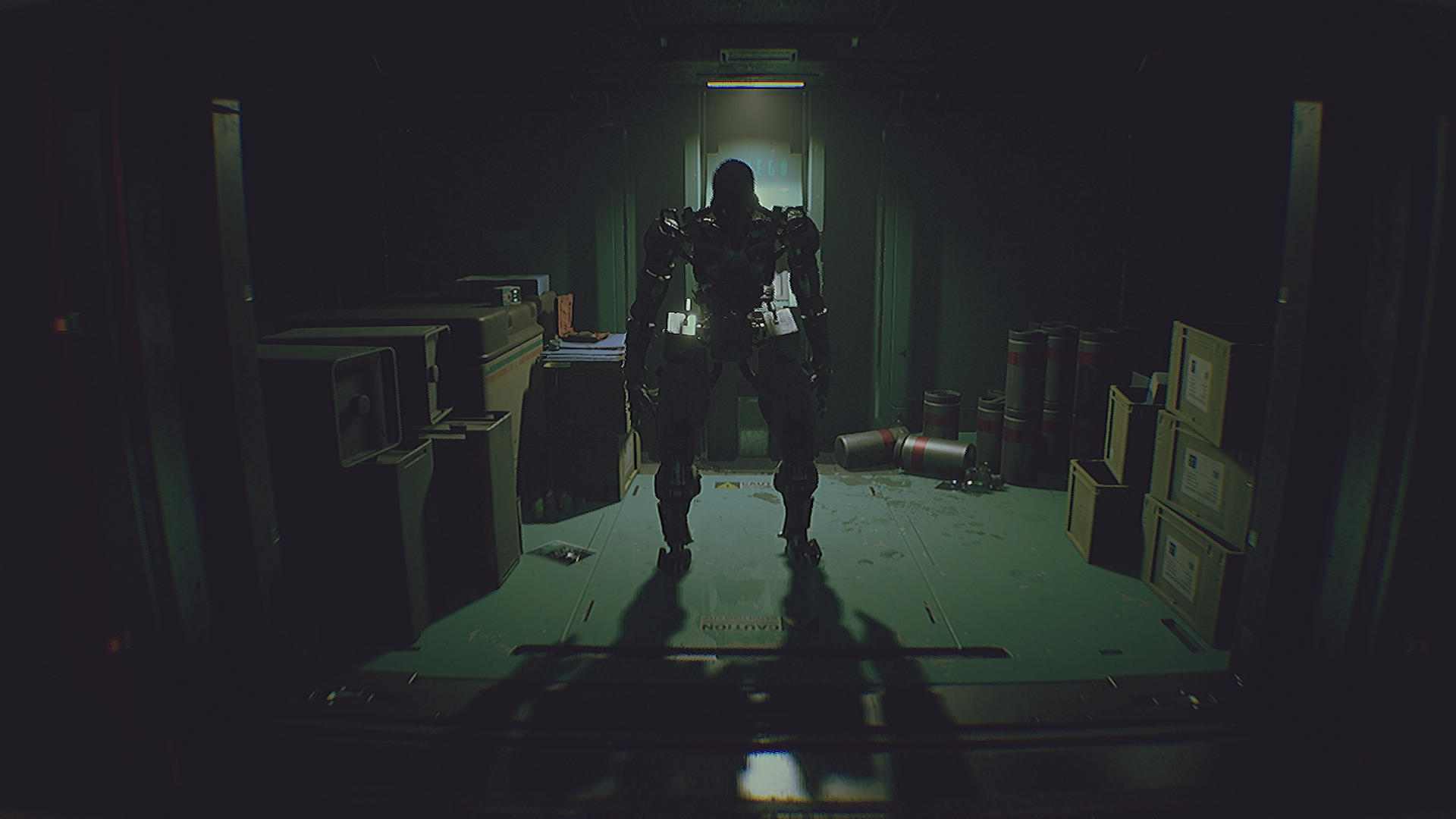Our Verdict
It's a monstrous amount of money to spend on a gaming PC, but when you're getting a system so monstrous as this RTX 5090-powered Area-51 it starts to become more understandable. Though maybe not more acceptable, especially as pricing for Nvidia's top-end card begins to drop and the machines have no AMD configuration options as yet.
For
- Stylish, accessible new chassis
- Stellar gaming performance
- Runs quietly
- Almost easily upgradeable...
Against
- ...but not quite
- Fan configuration feels a strange choice
- No AMD option
PC Gamer's got your back
I wasn't adequately prepared for just how massive the new Alienware Area-51 is in the flesh. It's frankly enormous, especially compared with the rather meek little Aurora desktops of the last Dell gaming box refresh.
Those Auroras just felt like pretty standard mid-tower machines, with a rather dull, very Dell design. This Area-51, however, is a gaming PC absolutely in FULL TOWER MODE. And, you know what, I'm kinda into it. I don't know if it's just that I'm a little intimidated by its sheer presence—so maybe I'm feeling the need to be nice about it otherwise it's coming for my lunch money—but it's certainly an impressive thing when you pull it out of the box and turn it on.
I dig the smooth curves of its outer shell, the blue LED ring around the front intake area, and those absolutely massive twin intake fans. And that huge glass side panel giving unfettered visual access to the insides, where the amount of space somehow makes the portly RTX 5090 this system ships with look like a regular graphics card.
Oh yes, this is the Area-51 given the full Alienware beans. So, the review system I have next to me is pretty much top-of-the-line across the board. On the one hand, ooh, this is the fastest gaming PC I've had on the test bench, on the other it's so hard to get anything that isn't the absolute top spec out of the company for testing. And I don't have the deep pockets to drop a couple grand on a mid-range version to see how that might turn out by comparison.
Still, this is a fitting spec for such a monstrous PC; there's the RTX 5090 for a start, working cheek-by-jowl with the Intel Core Ultra 9 285K and 64 GB dual-channel DDR5-6400, with a 2 TB PCIe 5.0 Sk Hynix SSD doing the storage dance for you. And… er… yeah, the price. There's none of Razer's moment of clarity on its own slightly destructive laptop pricing; Alienware is still wearing its premium branding like some sort of armour against any consideration of sensible pricing.
This is a $5,300 gaming PC.
With the RTX 5090 itself costing around the $3,000 mark at the moment—though with deals that is starting to edge downwards again—that makes it maybe an understandable, if not at all acceptable price for most of us PC gamers.
Keep up to date with the most important stories and the best deals, as picked by the PC Gamer team.
Worth noting also that Corsair's Vengeance PCs, systems generally also labouring under high price premiums, are sitting well over the $5K price point for RTX 5090 machines, too. Feels slightly ludicrous for that to make the Alienware price par for the course, but here we are. And hey, with a PC of this size, you are at least getting a tremendous sense of value.
It does at least perform like a $5,000 gaming PC. This thing is lightning quick, from its PCIe 5.0 SSD cold boot time, to the pace at which it can chew through games. The only misstep is in Baldur's Gate 3 where you can see what benefit you can get from having a Ryzen 3D V-Cache CPU inside your rig instead of being restricted to an Intel Arrow Lake chip. Otherwise it's plain sailing for the Area-51 in anything you throw at it.
With all our PC testing carried out at 1440p, the Area-51 is top of the class in terms of any prebuilt PC that we've looked at in recent times. And, well, ever. The only other machine we've seen that can beat it is a system we put together for a previous feature which packed an RTX 5090 inside a case with a Ryzen 9 9950X—and even then they trade blows.
You could maybe go faster with a Ryzen 3D V-Cache chip, such as the Ryzen 9 9950X3D, especially in Baldur's Gate 3, but this machine is about as fast a gaming PC as you can get in Intel trim. It's not just in gaming terms that the Area-51 can top the class, either, because that Intel Core Ultra 9 can also deliver when it comes to heavily multi-threaded workloads, too. And, even if I'm not sold on the config, the cooling does a great job of taming the CPU's heat demands.
Something else I've been really impressed with are the noise levels. Stick it in Performance mode and it will push both the CPU and GPU to their fullest, and during heavy operation you will certainly hear those fans spinning up. But, drop it to the Balanced mode in the Alienware Command Center (ACC) app and it will dial back the CPU while keeping the graphics core running hard.
With the CPU and its cooler being the hottest and loudest component pairing, that means you get a quiet system without compromising on gaming performance, and that is a bit of a win, for sure. The little bit of configuration nuance allowed by the Alienware Command Center software means you're getting a system that is actually pre-tuned in a way many other prebuilt PCs might not be out of the box. With something like Corsair's Vengeance machines not shipping with an iCUE configuration, that makes the ACC app a welcome little bit of bloat on the otherwise clean OS install.
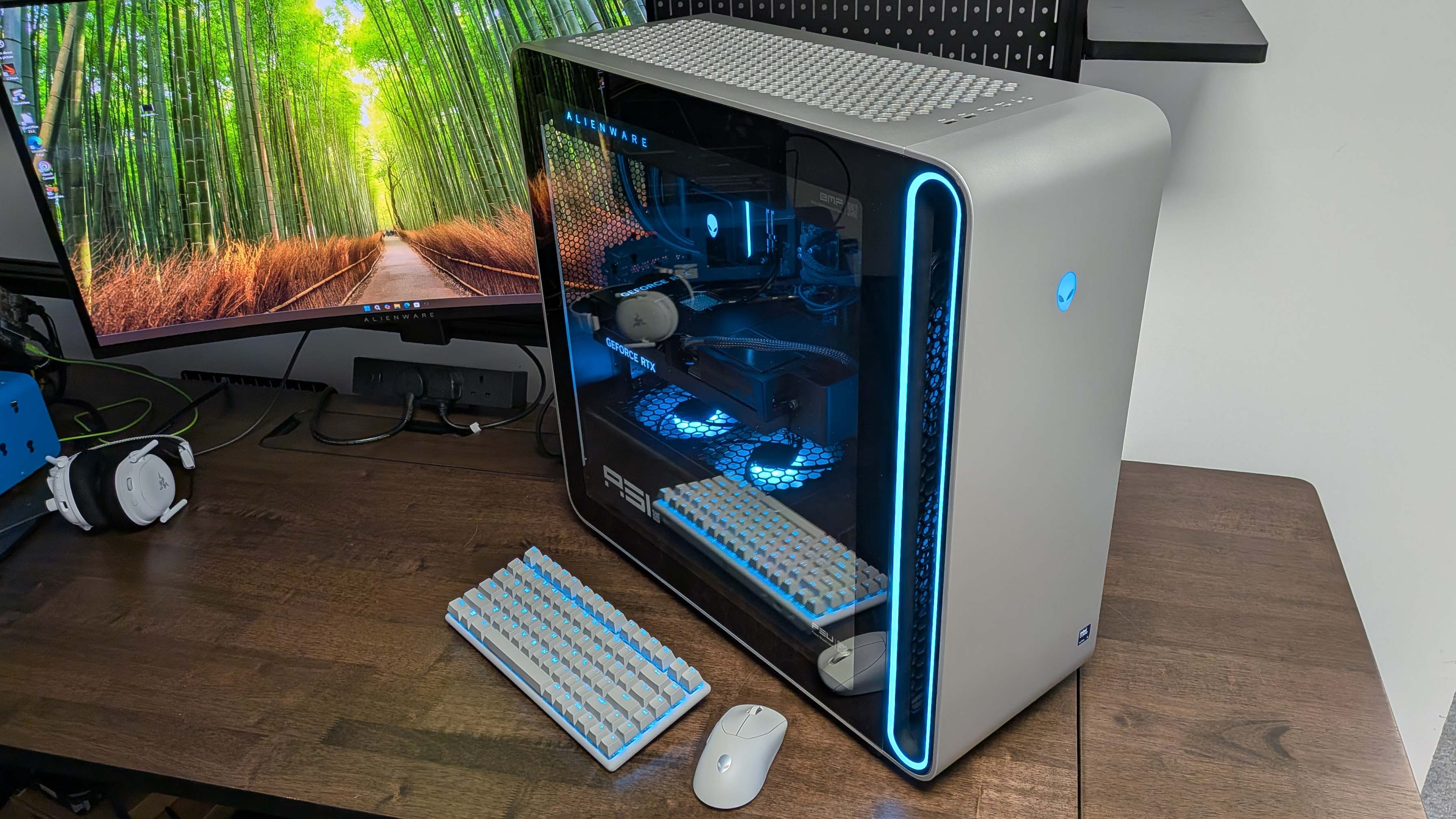
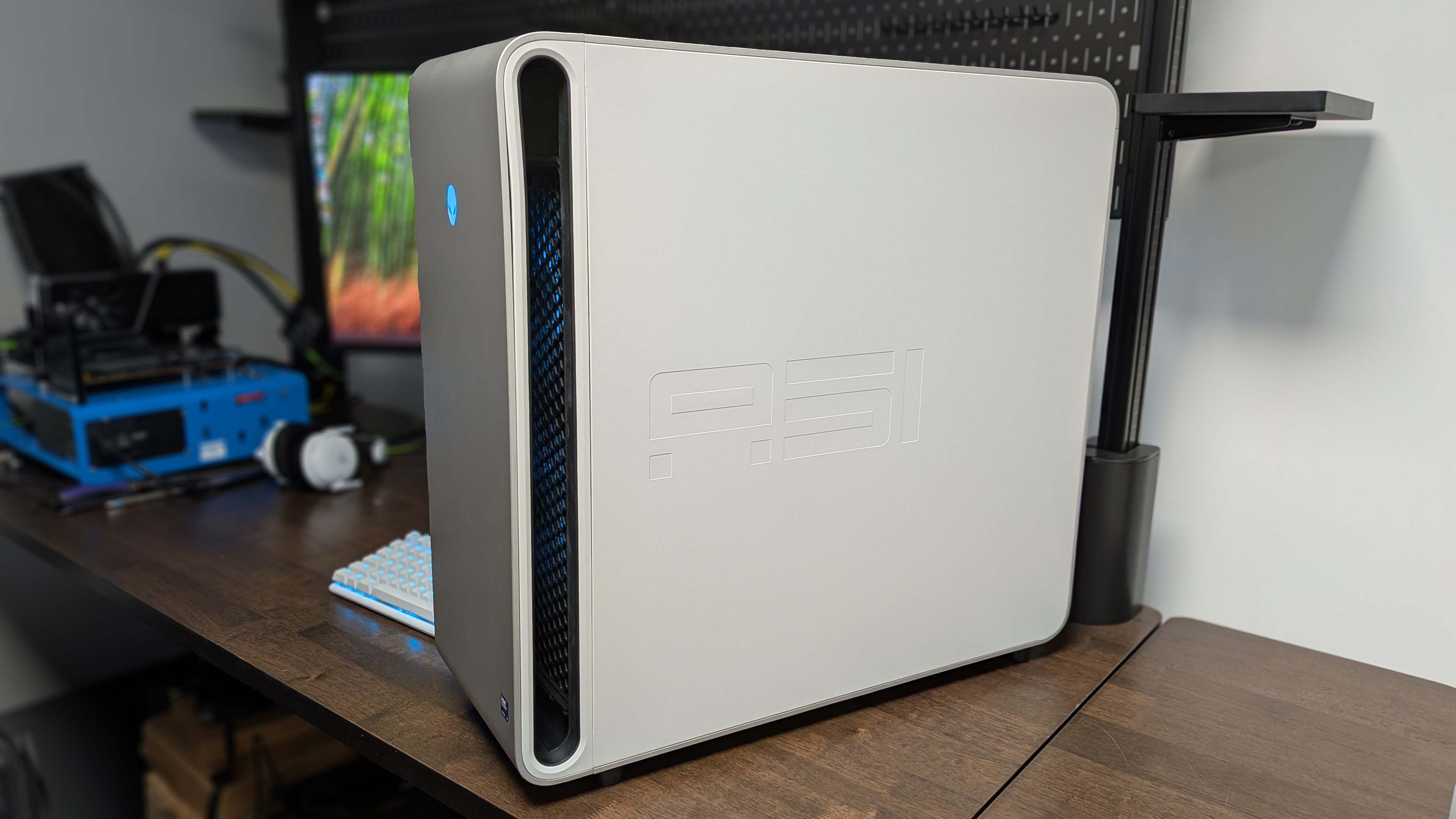
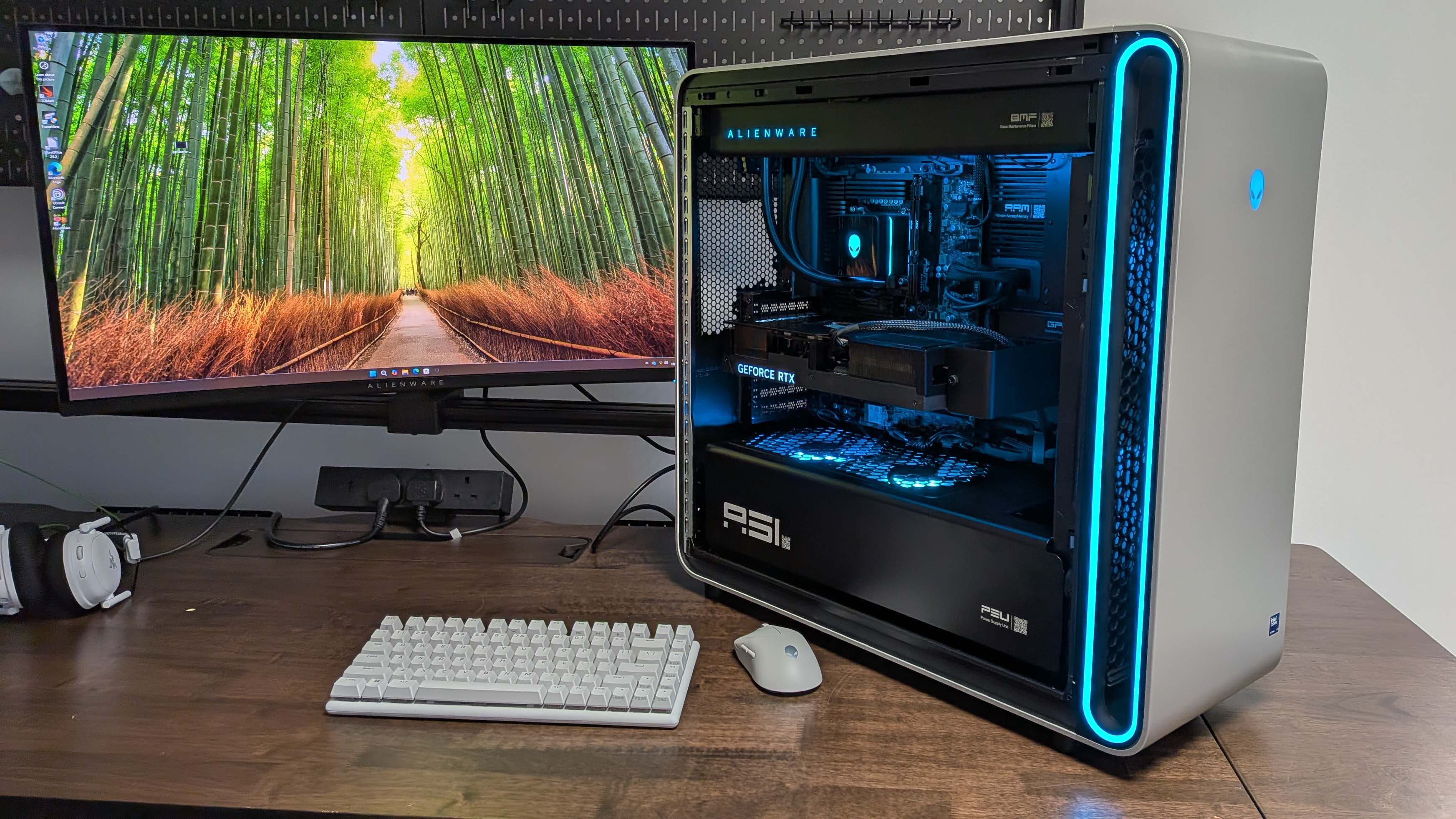
There are still proprietary connections if you want to be able to do such things as change the AlienFX RGB lighting or, y'know, turn the damned thing on.
But this is Alienware, so we have the ever-thorny issue of proprietary parts. The good news here is that, essentially, the new Area-51 is harking back to the days of upgradeable Alienware machines, when once there was the option to simply use off-the-shelf parts to modify your PC down the line. All the old Auroras would let you swap out GPU, memory, and storage, but they regularly had weirdly sized and laid out motherboards that looked like they were ripped right out of some bizarre Dell corpo PC box. Because they probably were.
Now, the motherboard in the Area-51 is still pretty industrial-looking, with a million tiny chips and chokes on display, like miniature cyberpunk cityscapes, with only a few stylised heatsinks covering things up. We've become used to all that being hidden by modern mobos and their flashy shielding, not so with the Intel board inside the Alienware. But it is at least of standard ATX scale, with the same screw points as every other off-the-shelf motherboard. So, mobo upgrades are a doddle, then. A win for Alienware and one of the biggest issues we've had with its PCs dropped in one fell swoop.
Except, not quite.
The chassis itself isn't all that compatible, because there are still proprietary connections if you want to be able to do such things as change the AlienFX RGB lighting or, y'know, turn the damned thing on. To be able to connect all the front panel, case cooling, and lighting gubbins up to a third-party motherboard you'll need to pick up a $35 conversion kit, which comes with all the cables and adapters you might need.
Well, not exactly all, because the beefy 1500 W PSU this machine ships with is of the ATX12VO variety which ditches all the largely unnecessary 5 V connections and gives you a much smaller motherboard power connection. Which is great, except you're going to struggle to find another third-party motherboard that will take that connection, and there's no safe adapter on the planet that will help. So, you're going to need to pick up a new PSU, too.
How much of an issue that actually is will only be something you can answer yourself. Me? I have a tendency to do in-place platform upgrades on my PCs rather than pick up a whole new system from scratch, but I know that's not everyone. Especially not everyone who might buy a $5,000 Alienware in the first place.
The DIY market is loud, but small. And the notion of future-proofing your build, with the potential for in-place upgrades down the line, actually only caters to a vanishingly small minority of PC gamers. And I wonder how many $5,000 PCs from any manufacturer actually end up having their motherboards ripped out and replaced by the original owner even if they're entirely off-the-peg, like a Corsair Vengeance. I would wager precious few.
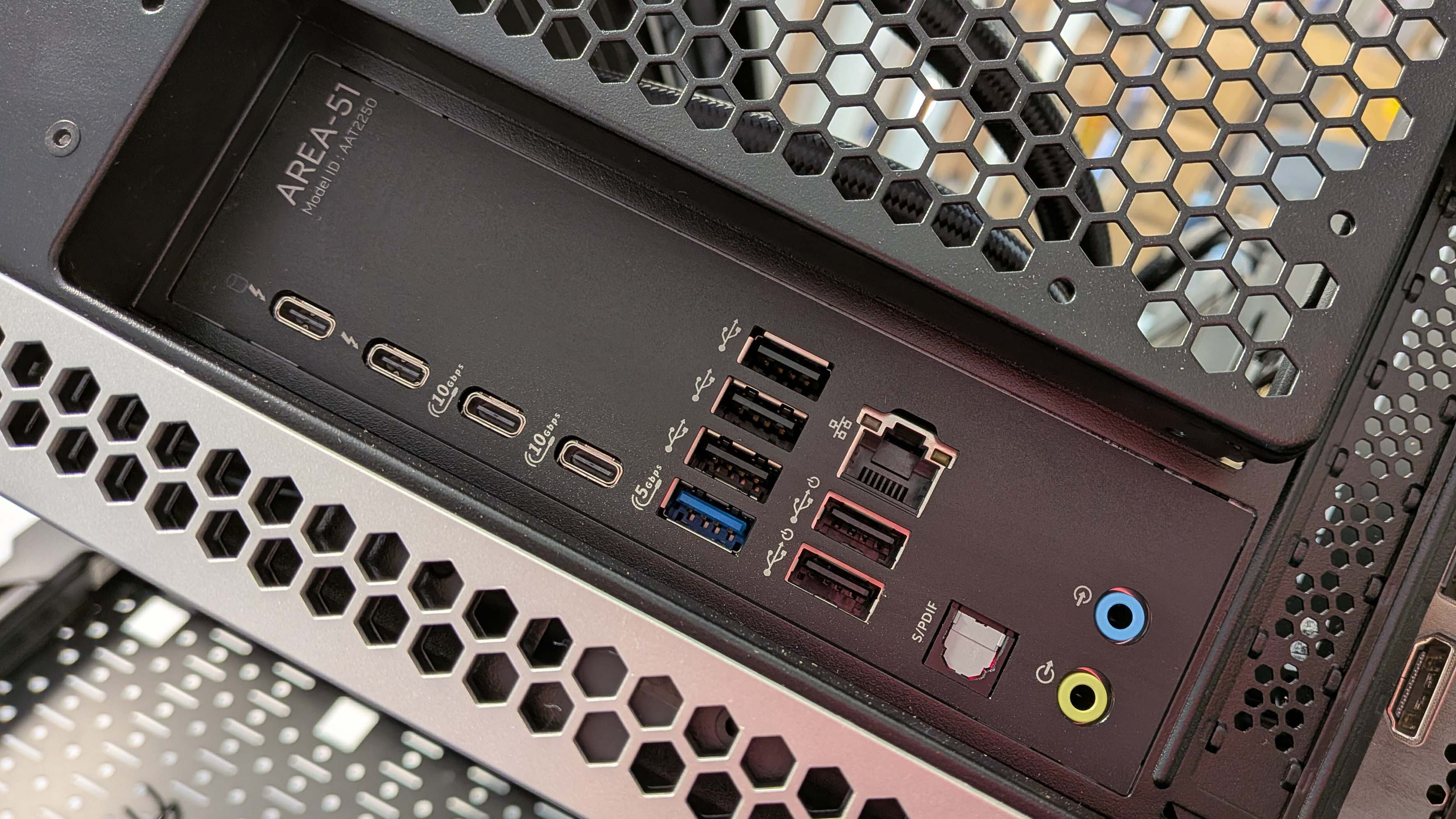
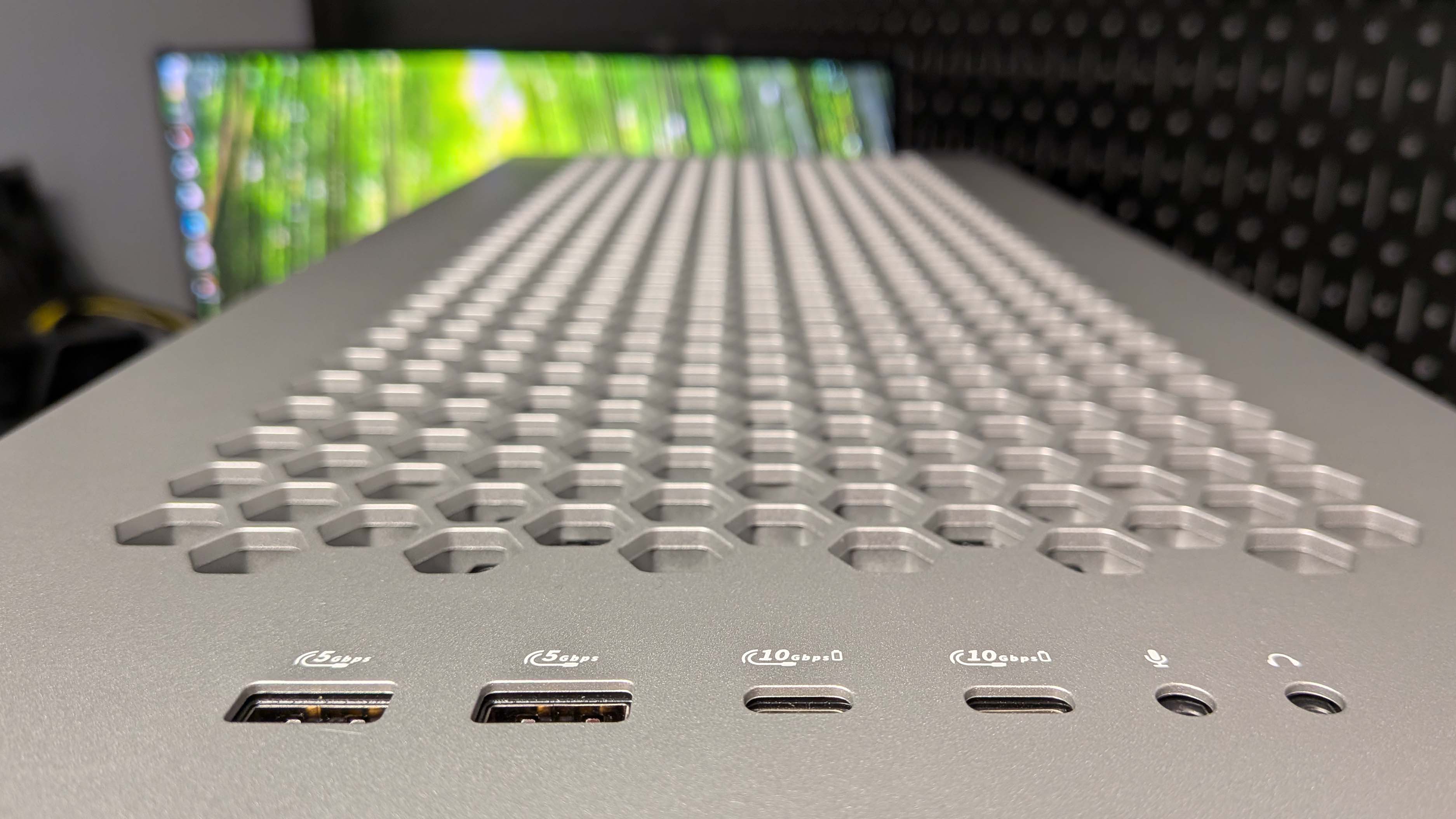
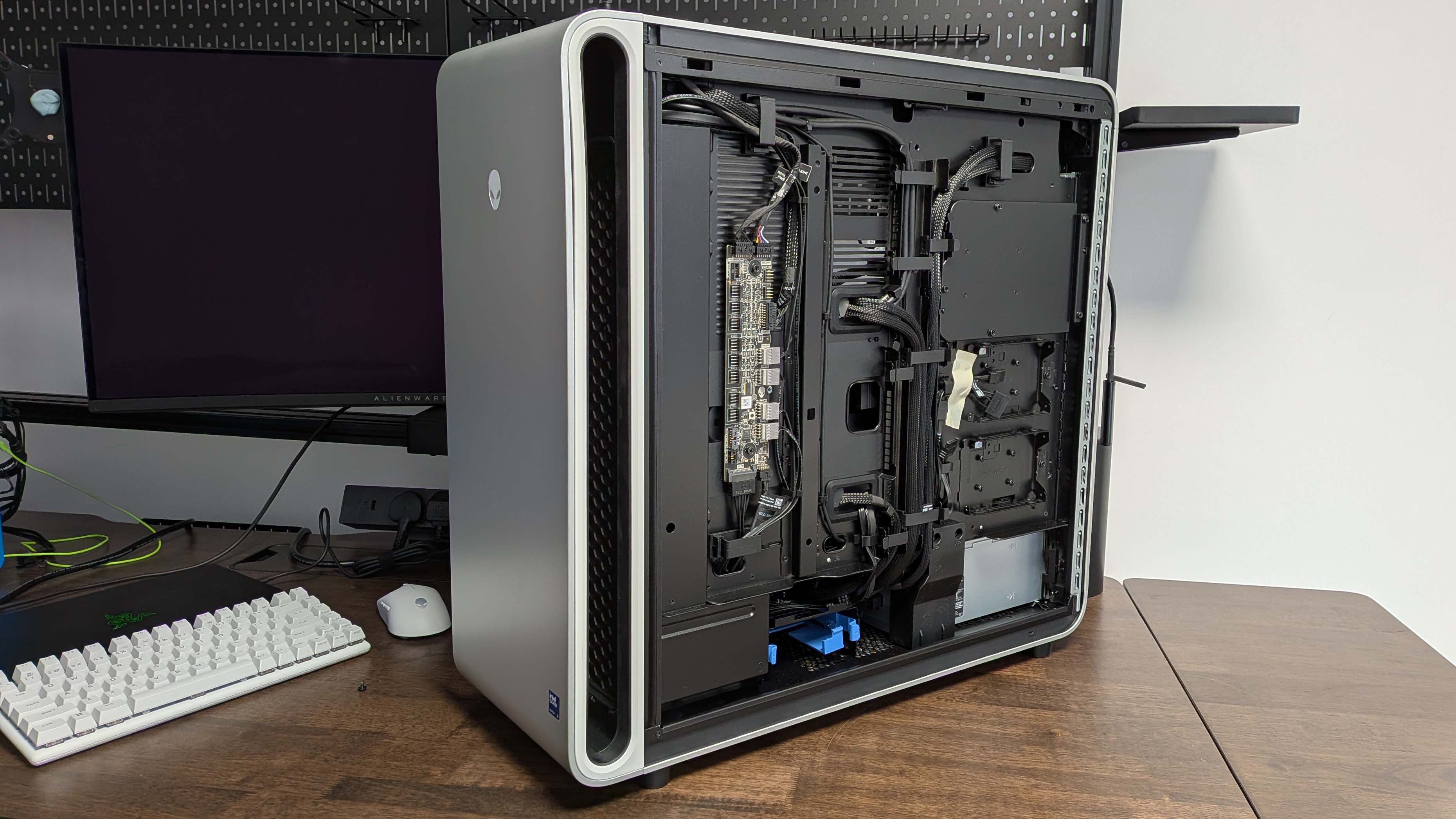
What I will say is the motherboard in there is relatively well appointed for an Alienware rig. There are only a pair of M.2 slots for internal storage (one PCIe 5.0 and one PCIe 4.0), but I've never seen a system with quite so many USB Type-C ports on it. There are a pair on the front panel of the machine, with another four on the back panel of the board itself. Two of the six are Thunderbolt ports, while the rest are 10 Gbps sockets. There are a further six Type-A ports, though with only one of them designated as 5 Gbps, on the rear and another two USB 3.2 Type-A 5 Gbps ports on the front panel.
And it all feels very well put together, from the super rigid bracketing keeping the RTX 5090 in place and from dragging the PCIe slot down with it, to the cable routing in the rear of the machine. There are power and data cables already tidied into place around the spare 2.5-inch and 3.5-inch drive bays in case you want to jam in some ancient SATA SSDs or spinning platter storage, which is a welcome touch.
That impression somewhat changed when I started checking out the cooling. It actually cools the system impressively well—running on Performance mode, yes it gets chatty, but stays chill and in Balanced mode it's quiet but still delivers on gaming frame rates. But I'm not sure I'm into Alienware's cooling config.
In a gaming PC, good airflow is a positive thing. And when you've got a ton of fans in a rig it's important to make sure they're blowing in the right directions, which normally means not having them all blowing in the same direction. The twin 180 mm fans on the front are intake fans, pulling cool air in to help cool the system as a whole, then there are a pair of 140 mm fans set just above the PSU ostensibly to pull cool air in from the bottom to pass up and across the GPU.
Finally, there are three 120 mm fans atop the 360 mm radiator. In most modern builds, those are used to pull the hot air out from the PC, over the radiator drawing more heat from the coolant to help chill the CPU itself.
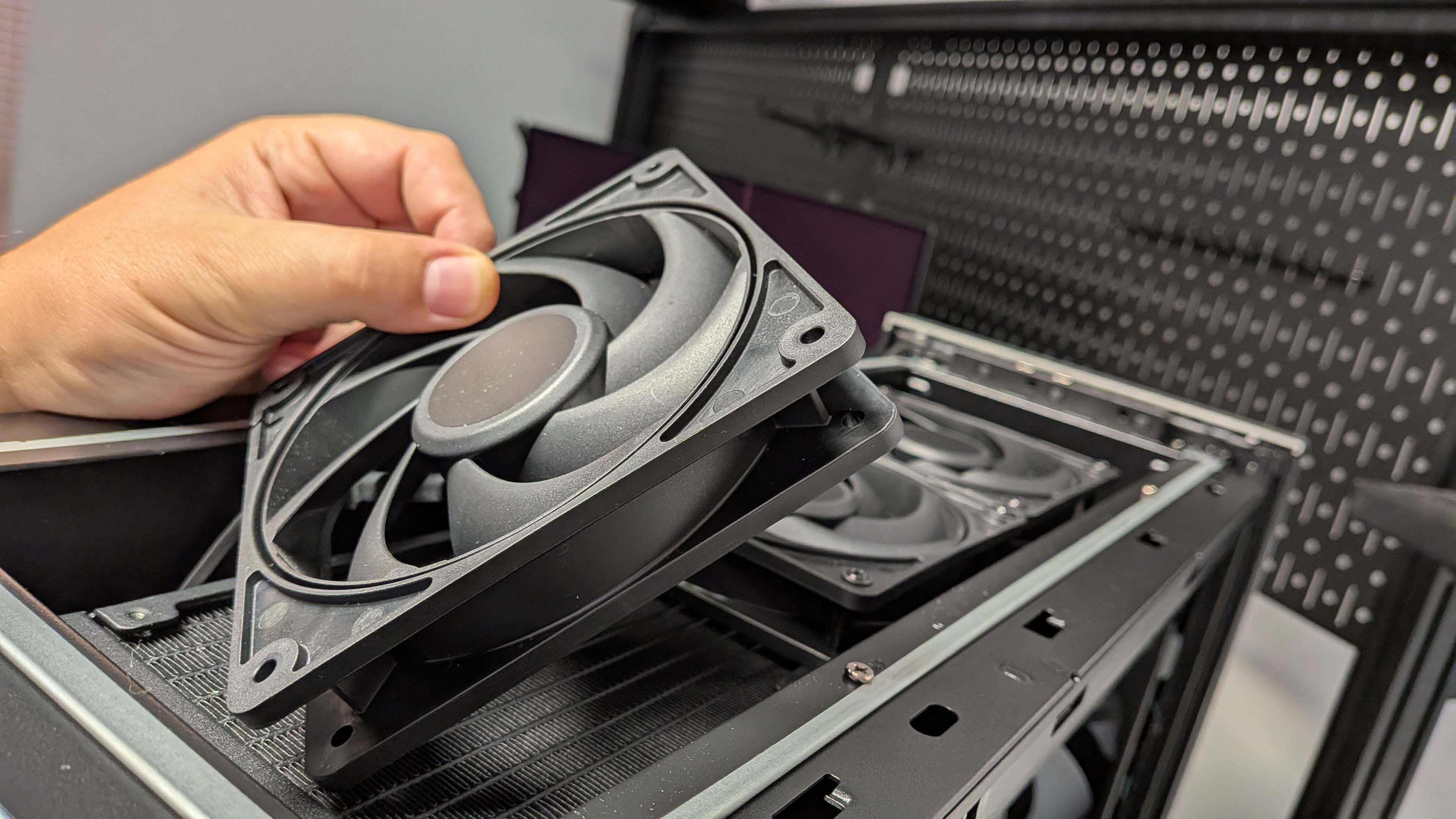
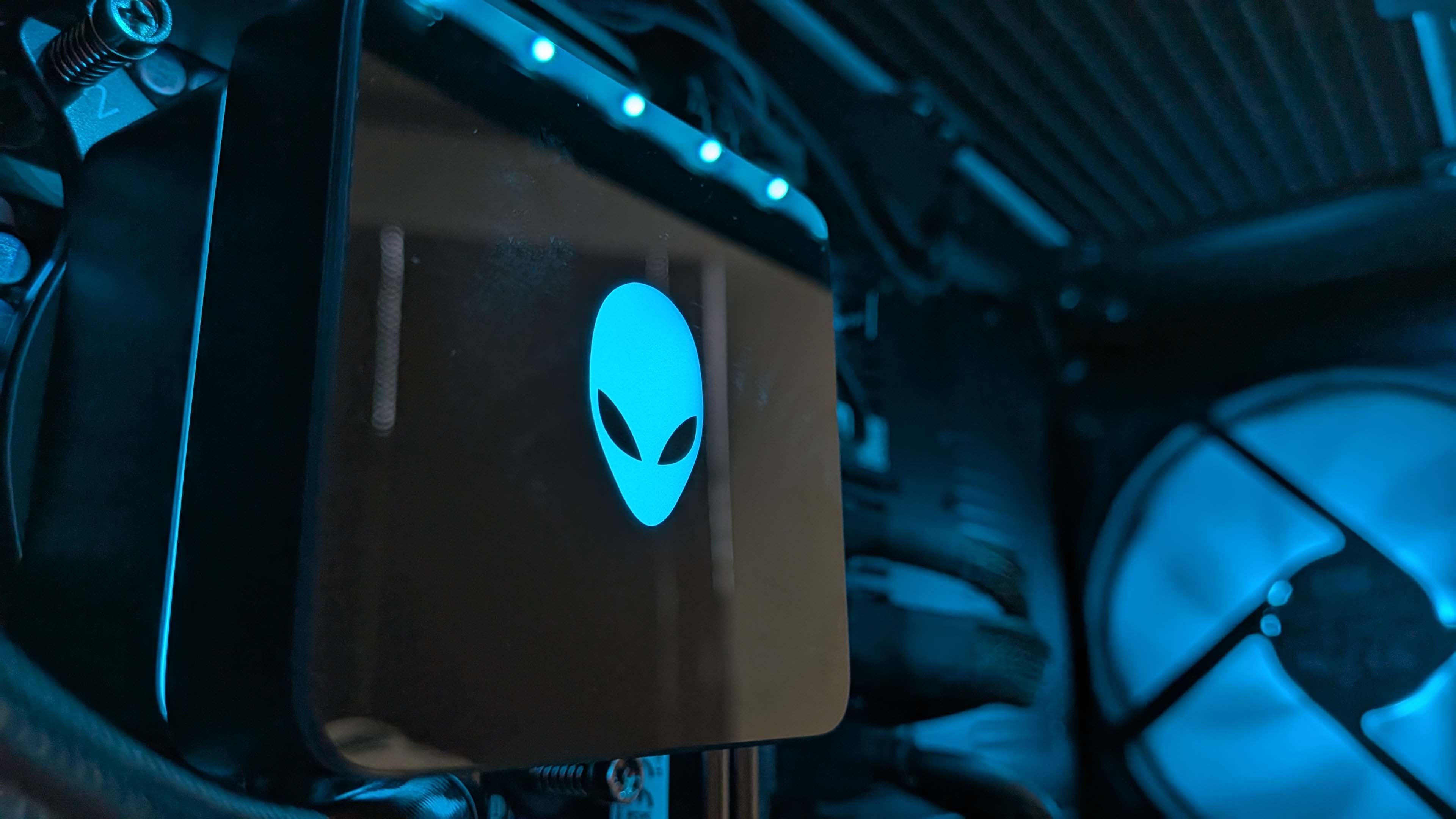
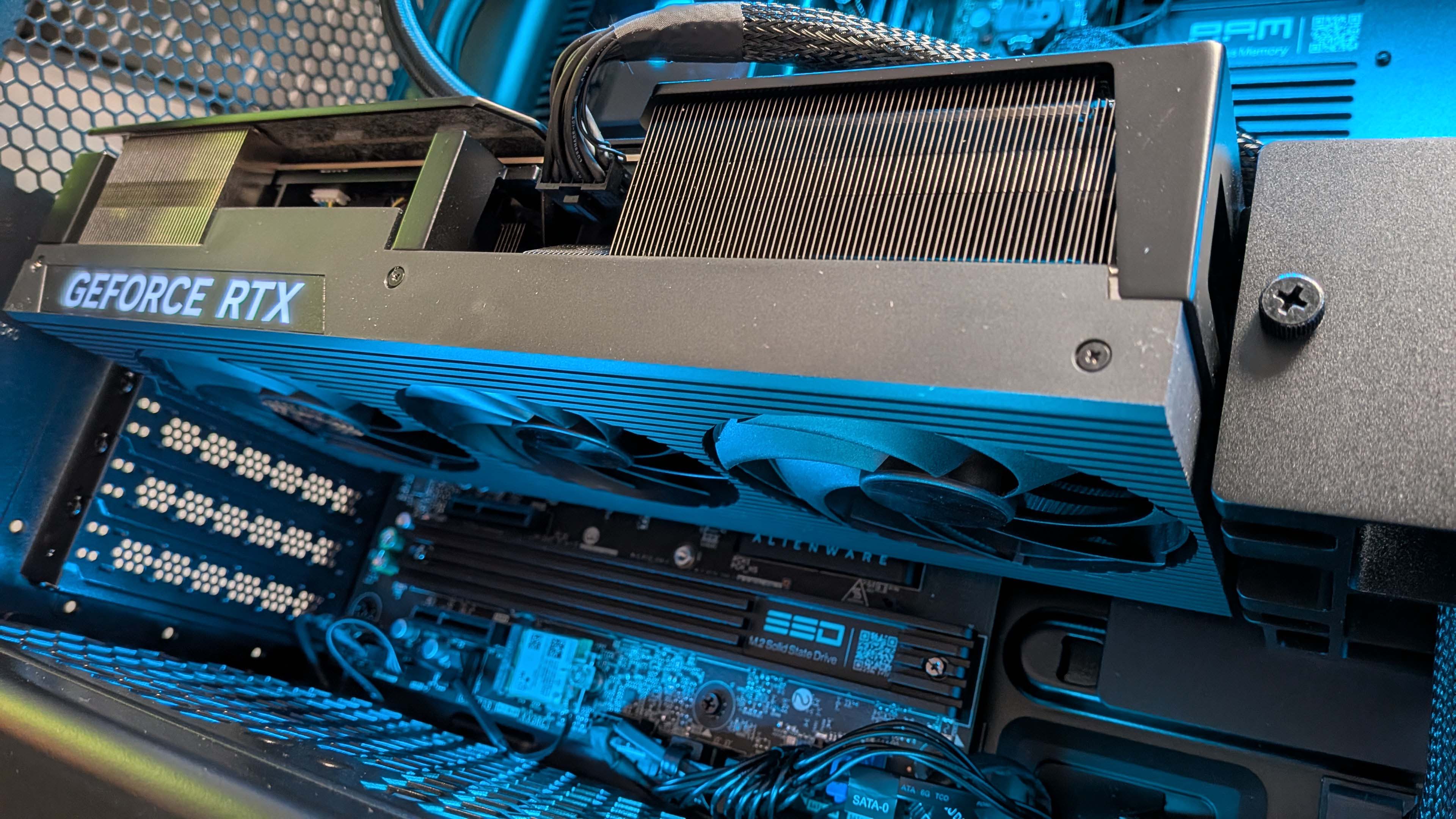
Whatever my misgivings might be it does it all in a quiet restrained way. Well, as restrained as any PC of this scale can.
Except that's not what Alienware is doing. It's working with complete positive pressure, with every fan in the rig pointing inwards, drawing cool air in with no active exhaust.
"Our engineers conducted countless simulations with different fan orientations and determined that, for this chassis, having all fans point inward optimizes cooling and acoustics while scaling for even higher wattages than what is available today," Alienware told me when I queried the configuration. "By having all fans point inward to create positive pressure, Area-51 desktop can omit an exhaust fan and operate at low noise levels while effectively cooling the most important components (CPU and GPU)."
The company cites 45% quieter operation and 25% more airflow than previous Aurora chassis, but I did swap the fans around myself to test the difference. Mostly because I initially thought it was a mistake on the part of the PC builders, with the printing on the chassis seeming to indicate the direction of airflow out the top of the case.
In my testing I've seen the CPU running at least a couple of degrees cooler during heavy, sustained usage, and the graphics card running either the same or sometimes a little cooler, when the radiator fans are set to exhaust the hot air. I'm sure Dell has carried out a ton of thermal testing on this setup, but I'd be far happier having at least some of the fans dedicated to shifting out that hot air.
Total positive pressure means air gets heated up inside the chassis and can only escape through the gaps passively. This means hot air sticks around longer, getting hotter and insulating your components with toasty air. Of course the air can get out, but isn't going to move as quickly as if there's something actively pushing it out. With all that hot air trapped in there, it's also harder to get cool air squeezed in, so the fans have to work that bit harder.
It is a pretty cool and quiet machine anyways, I just feel it could just be a bit cooler. But then, I've not conducted countless simulations…
There's one other issue on the fan front, and that's the rear most fan above the PSU. One of them is literally above the power supply itself, and there is zero clearance between it and the fan, which renders its existence pretty much pointless. With no real possibility of pulling in cool air itself, that fan is aesthetics, pure and simple.
My concerns about the fan configuration aside, this is the most impressed I've been with an Alienware PC in a long time. In both games and creative applications it performs as well as you would expect from the components the company has jammed inside, and whatever my misgivings might be it does it all in a quiet restrained way. Well, as restrained as any PC of this scale can.
✅ You're willing to spend big on a seriously powerful gaming PC: Out of the box, the Area-51 will deliver gaming and content creation performance that, thanks to its high-end parts, is top of the class in prebuilt PCs. But to hit that level of performance you need to spend a ton of cash to get there.
✅ You want a quiet-running system: The Alienware Command Center allows for top-end gaming performance without the noise levels you might normally expect from a powerful gaming PC.
❌ You want a discreet PC: There is nothing subtle about the Area-51; it's a massive gaming PC that wants to be front and centre of your gaming setup.
❌ You want an AMD system: Currently Alienware is only kitting out the Area-51 with Intel Arrow Lake chips, which is a real shame given the power of AMD's 3D V-Cache processors.
❌ You want an easy upgrade path: This is as upgradeable as modern Alienware machines have been, but the choice of ATX12VO PSUs makes the list of compatible motherboards vanishingly small, meaning you'll need to replace the power supply whether you need more power or not.
It's a scale I can dig, though, with a solid, accessible design that allows easy access to most of the parts inside. Is it the easily upgradeable Alienware we were promised? Not quite. Honestly, I can kinda forgive the $35 upgrade kit of cabling for integrating the chassis design and cooling into a future third-party motherboard replacement, but the ATX12VO PSU choice is going to make that 1500 W power supply it ships with a pain to replace if and when you do want to upgrade.
Which means I'm always going to come back to why would you want the Alienware Area-51 over an equivalently specced and equivalently priced PC from another vendor? I appreciate the tuning via the Alienware Control Center app, which means you can run a chilled system out of the box without having to tune it yourself, and I like the curvy chassis. And if it weren't for the pain of a PSU upgrade down the line I'd say it all evens out. Especially as Dell has a propensity to discount its gaming PCs on the regular; our standing advice about not paying full price for an Alienware machine remains.
What would have me pausing on the Alienware more than its potential upgrade hiccups, however, is the choice of CPU supplier. Dell has decided that its Area-51 range, at least for the moment, are entirely Intel-based. In a world where AMD is currently the top-dog in gaming chips, that would probably have me looking elsewhere if prices are the same.
So, there is still a little grit in the eye of this beholder as I gaze upon the beauty of this Area-51 gaming PC, but I could probably blink that away quite happily once I started gaming on this behemoth.
It's a monstrous amount of money to spend on a gaming PC, but when you're getting a system so monstrous as this RTX 5090-powered Area-51 it starts to become more understandable. Though maybe not more acceptable, especially as pricing for Nvidia's top-end card begins to drop and the machines have no AMD configuration options as yet.

Dave has been gaming since the days of Zaxxon and Lady Bug on the Colecovision, and code books for the Commodore Vic 20 (Death Race 2000!). He built his first gaming PC at the tender age of 16, and finally finished bug-fixing the Cyrix-based system around a year later. When he dropped it out of the window. He first started writing for Official PlayStation Magazine and Xbox World many decades ago, then moved onto PC Format full-time, then PC Gamer, TechRadar, and T3 among others. Now he's back, writing about the nightmarish graphics card market, CPUs with more cores than sense, gaming laptops hotter than the sun, and SSDs more capacious than a Cybertruck.
You must confirm your public display name before commenting
Please logout and then login again, you will then be prompted to enter your display name.
